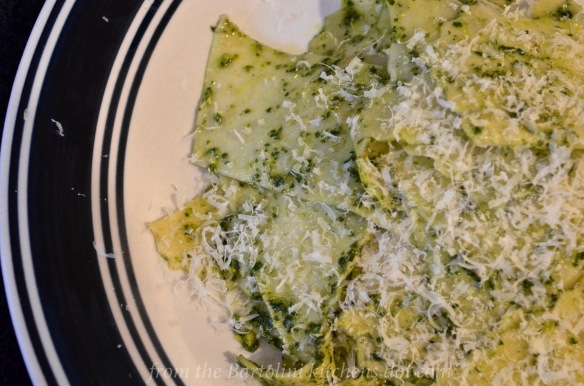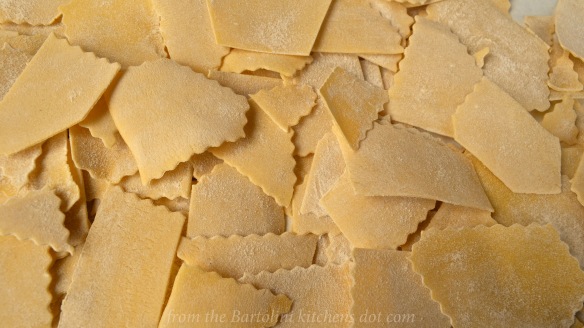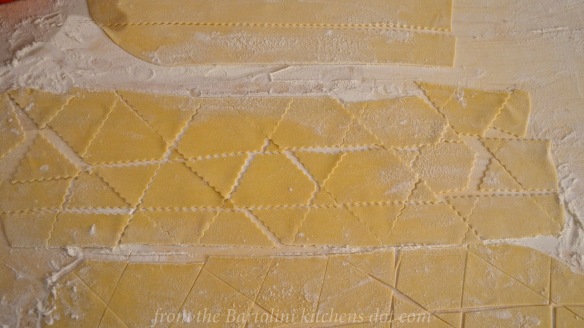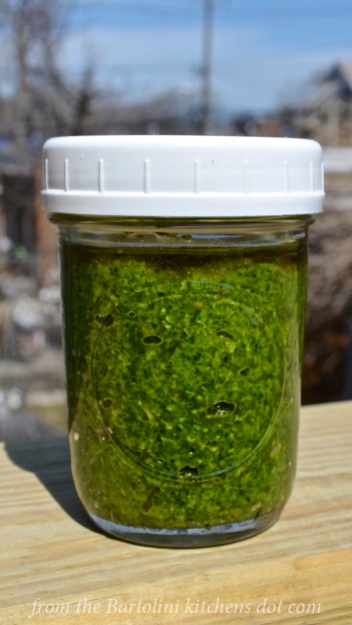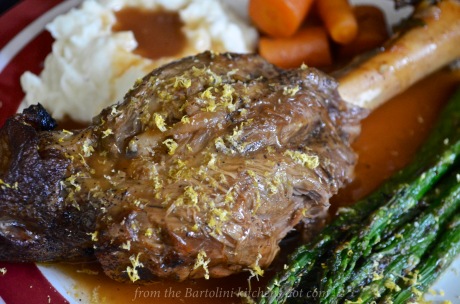Maltagliati con Pesto al Pistacchio
Today’s post is one of odds and ends, literally. Sure, there are two “recipes” to be shared but neither is deserving of its own post, both being incredibly easy to prepare. One, in fact, is traditionally nothing more than scraps, giving more proof to the adage that nothing is wasted in an Italian kitchen.
Maltagliati is a pasta of irregular shapes, the name of which is derived from the Italian words for badly cut, male taglio. (Thanks, Francesca, of Almost Italian). It is the end pieces and leftover bits of pasta that result from a day of pasta making. Like snowflakes, no two pieces are alike, each being randomly cut. The fact that there would be enough scraps to prepare a dinner is an indication of the difference between our two countries’ eating habits.
By one estimate, the average per capita consumption of pasta in Italy is 59 pounds per year, while in the US it’s only 19 pounds apiece annually. Yet we have an obesity epidemic. The reality is that a one pound package of pasta will yield 8 servings in most Italian kitchens. They will serve one such serving with most evening meals, the primo piatto. Here, we’ll get 5, 4, or even 3 mega-servings from a single pound. That serving is often the main course, with the addition of a salad, bread, and possibly a dessert.
Most of our pasta is manufactured and store-bought. Up until recent times, the vast majority of pasta served in Italian homes was made by hand. If you make enough pasta so that everyone in your household is going to eat 59 pounds of pasta per year, you are bound to have a lot of scraps to deal with. Those scraps can become maltagliati and will be served in any number of ways, usually determined by the amount at hand.
Very often, they’re served with beans, taking the place of the ditalini used in last week’s Pasta e Fagioli recipe. If you’ve plenty, they can be served with a hearty meat sauce, as was served to Zia and me one evening in Rome, where I first heard of this pasta. Here, I’ve chosen to serve them with a new version of pesto, simply because I needed a pasta narrative to accompany the recipe for today’s pesto. It would have been an incredibly short post, otherwise.
* * *
Yes, that’s the first, lonely crocus to bloom in my front garden. Spring is finally taking hold and  with the new season comes an offer from my blogging friend, Mary, of Love – The Secret Ingredient. She is creating surprise boxes that will contain various gourmet items, small kitchen products, and recipes which will use the enclosed items. A box will be delivered every season and you can purchase them separately or all four at once. The part that caught my attention is that Mary will donate 10% of the annual profits to Feed The Children, an organization dedicated to providing hope and eliminating hunger. You can learn all about Mary’s Secret Ingredients by clicking HERE.
with the new season comes an offer from my blogging friend, Mary, of Love – The Secret Ingredient. She is creating surprise boxes that will contain various gourmet items, small kitchen products, and recipes which will use the enclosed items. A box will be delivered every season and you can purchase them separately or all four at once. The part that caught my attention is that Mary will donate 10% of the annual profits to Feed The Children, an organization dedicated to providing hope and eliminating hunger. You can learn all about Mary’s Secret Ingredients by clicking HERE.
Note: Although I’ve ordered and paid for a surprise box, I have not received any form of compensation for mentioning Mary’s offer. I saw this as an opportunity to help a fellow blogger and worthwhile charity at the same time.
.* * *
How to Make Maltagliati Pasta
- If you make a full recipe of Mom’s Pasta Dough, you will have about 1.5 pound (680 g) of pasta dough. That will make quite a bit of pasta, so, you may wish to halve the recipe or cut it into 3rds or 4ths. For this post, I cut the pasta recipe in half.
- Take a portion of the dough and run it through the pasta machine rollers until it is as thin as you like. My rollers start at 1, the thickest setting, and I continue to roll the dough, up to and including the 6 setting. You may like your pasta thinner. If so, continue to advance the setting as you roll the dough.
- Lay the dough strip out flat on your work surface, dust lightly with flour, and allow to rest for a few minutes.
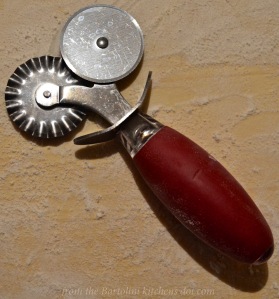 Use a straight-edged pastry cutter to divide the strip into 3 equal strips. No need to worry about it being a perfect straight line. Just do the best you can. Do not separate them but leave them as-is.
Use a straight-edged pastry cutter to divide the strip into 3 equal strips. No need to worry about it being a perfect straight line. Just do the best you can. Do not separate them but leave them as-is.- Now, take your pastry cutter and beginning in the upper left corner, make a series of diagonal cuts, approximately parallel to each other. Once done, starting in the upper right corner, make diagonal cuts going the other way, repeatedly, You will end up with a collection of triangles and trapezoids, no two exactly alike — not to mention a better appreciation of your Geometry teacher who predicted that “one day this ‘stuff’ will be useful.”
- Place them in a single layer on a wax paper covered baking sheet that’s been lightly dusted with flour or corn meal.
- Repeat until all the dough strips have been cut. If you like, use a fluted-edged pastry wheel to cut the pasta, as well as the straight-edged. This will further the illusion of this being a pasta dinner made from scraps. (see Notes)
- To cook, bring a large pot of heavily salted water to boil, add the maltagliati, stir, and allow to cook for a few minutes. Being freshly made, they should be fully cooked within minutes. Taste one when all have risen to the top of the pot of boiling water.
- Drain and dress with pesto, recipe to follow. (See Notes)
* * *
Notes
Not everyone has time to make pasta, even when the process is as easy as this. Should that be the case, take some store-bought lasagna noodles and snap them. Just don’t get carried away, for it is easier to dine on larger pieces than tiny ones.
Being flat, maltagliati have a tendency to stick together once drained, so, you must work fast. Once the pasta has been drained, quickly give it a light coating of olive oil before dressing it with the pesto. If using a red sauce, there’s no need for the olive oil but you still must quickly add it to the drained noodles.
* * *
So, now that you’ve got a scrappy little pasta at your disposal, it’s time to dress it.
I certainly won’t pretend to speak for everyone but I will say that by this time of year, I’m desperate for any kind of Summer dish. Pesto for me is one such dish. In Summer, I can get a wedding-sized bouquet of basil for a couple of dollars at the farmers market. This time of year, I’m lucky to get a few stems for the same price. Today’s pesto recipe gives me my Summer fix without breaking the bank, for not only does it use half the basil, it substitutes pistachio nuts for the über expensive pine nuts, pignoli. (Just last month, I saw a 4 oz package (113 g) of imported organic Italian pine nuts with a price of $12.99. That’s $52.00 a pound!!!)
Whether you’ve made pesto before, you shouldn’t have any problems preparing this recipe.
* * *
Pistachio Pesto Recipe
Ingredients
yield: 1 cup pesto
- 1.4 oz (40 g) fresh basil leaves (See Notes)
- 1.1 oz (30 g) fresh, flat leaf parsley leaves
- .5 oz (15 g) roasted, unsalted pistachio nuts
- 3 cloves garlic, roughly chopped
- 1/3 cup grated Pecorino Romano cheese – Parmigiano Reggiano may be substituted
- 3 oz (79 ml) extra virgin olive oil – more or less to taste
- salt & pepper to taste
Directions
- Place everything but the olive oil, salt, and pepper in the bowl of a food processor.
- Let it process until a thick paste is formed.
- While the processor is still running, add the olive oil in a slow, steady stream until the pesto reaches the consistency you prefer.
- Taste and season with salt and pepper, as required. Pulse the processor to blend the seasonings with the pesto.
- Your pesto is ready for use.
* * *
Notes
The reason for the odd amounts of basil and parsley is because of how both were purchased. I bought a 2 oz package of basil that, once the stems were removed, actually weighed 1.4 oz. Similarly, I bought a bunch of parsley that, once cleaned, weighed 1.1 oz.
Traditionally, pesto is made using a mortar and pestle rather than a food processor. I do not own a mortar large enough to do this, so, I use a food processor. The fact that it is so much easier this way has nothing to do with it.
I used my pesto recipe as the basis for today’s version. You can use your own pesto recipe, just be sure to replace 25 to 50% of the basil with parsley and, of course, use pistachio nuts instead of pine nuts.
Refrigerate unused pesto in an airtight container, after topping with a thin coat of olive oil. Use it or freeze it within a few days.
If I’m going to freeze this or any pesto, I do not add cheese to it while it’s being made. I’ve found that the cheese doesn’t thaw well and the pesto’s consistency suffers. Instead, I’ll add the cheese to the pasta when the pesto is added.
If you have frozen pesto containing cheese, mix it with a bit of hot pasta water before using it to dress the pasta. The hot water will help make the pesto more smooth and easier to evenly coat the pasta.
* * *
It’s déjà vu all over again …
 With lawns going green and last Fall’s bulbs breaking the ground’s surface, it can only mean one thing. It’s dandelion picking season! What you may consider a blight on your lawn, a Bartolini sees as a crisp salad. Click HERE to see the lengths traveled by my Dad to enlist our help picking the greens for our Sunday night dinner.
With lawns going green and last Fall’s bulbs breaking the ground’s surface, it can only mean one thing. It’s dandelion picking season! What you may consider a blight on your lawn, a Bartolini sees as a crisp salad. Click HERE to see the lengths traveled by my Dad to enlist our help picking the greens for our Sunday night dinner.
* * *
Coming soon to a monitor near you …
* * *

